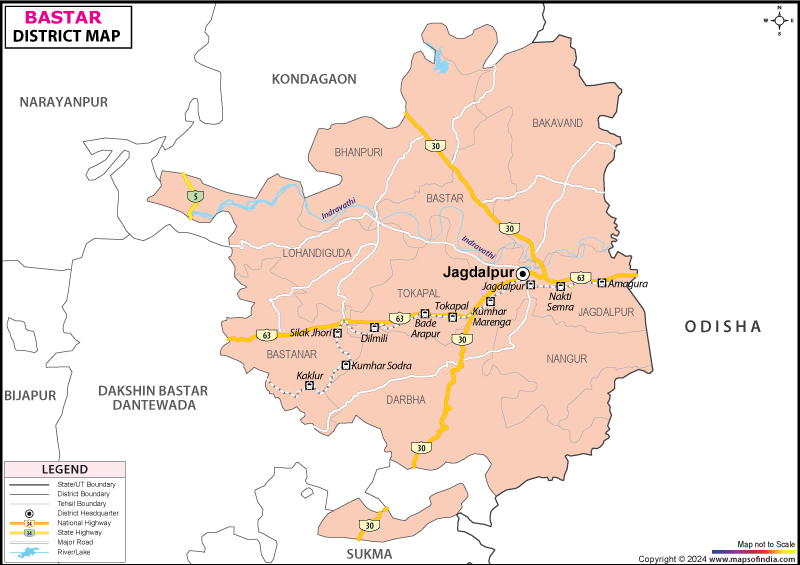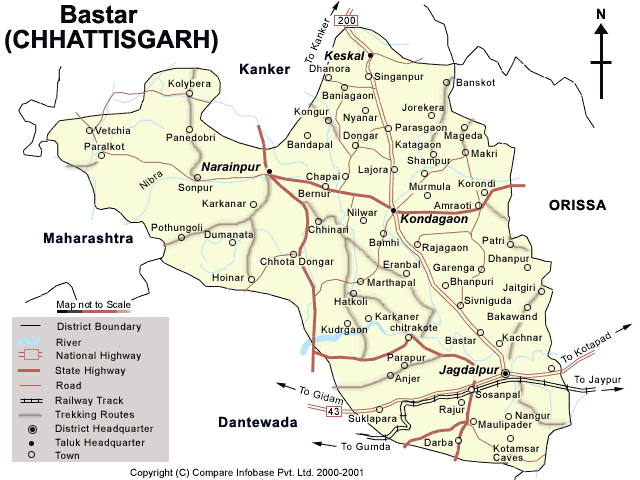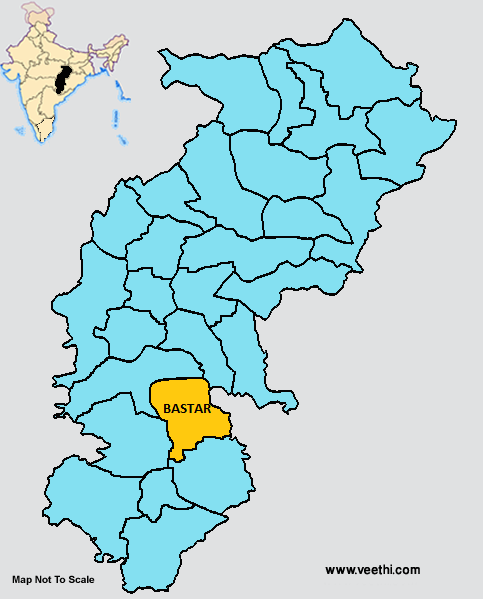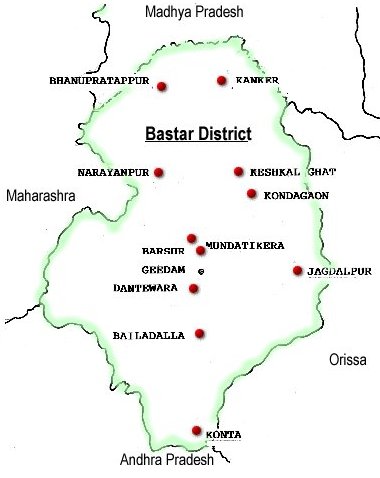Bastar district
The district Bastar is a district of the Indian state of Chhattisgarh. Administrative center is the city of Jagdalpur.
Geography and Agriculture
The district lies in the south Bastar Chhattisgarhs on the border with the state of Orissa. Neighboring districts Dantewada are in the southwest, Narayanpur in the northwest, Kondagaon (all Chhattisgarh ) and Nabarangpur in Orissa in the northeast and Koraput in the southeast. Before the spin-off of the district Kondagaon in 2012, the district Bastar had an area of 10,083 square kilometers. The district was divided into twelve Tehsils Keshkal, Baderajpur, Kondagaon, Makadi, Pharasgaon, Jagdalpur, Lohandiguda, Bastanar, Bastar, Bakaband, Tokapal and Darbha.
The area is located high on a plateau about 600 to 700 m. The district is still heavily wooded, but the trees in the rocky areas are stunted. There is dominated by Balanites rexburghii, Gerber acacia ( Senegalia catechu, locally called khair ) and Bombax malabaricum ( semar ). As useful trees the Palmyra palm ( Borassua flabifeller ) is most common. The proportion of irrigated fields is low, wet rice, with an average yield of 984 kg / ha, however, is the most important soil fertility. There is virtually no industry. A railway line runs from the terminus Kirandul about Jagdalpur to the east.
The Indravati, which flows through the district in the north west of the only major river. His is 30 m high waterfall Chitrakot a landmark in the district. From the south, opens the Dantewada.
History
The early history of the Bastar region lies in the dark. Some inscriptions seem to indicate that in the 11th century a Nagvanshi Dynasty, with its capital prevailed in Barsur. The kingdom was known under the name Chakrakot. The State of Kanker, was founded in 1192 by Bir Kanhar deodorant. The Chakrakot kingdom fell under frequent attacks from the south and eventually became part of the Rajput kingdom of Warangal Kakatiyas. Their most important ruler was Rudra Pratap Deo, who fell in a battle with Ahmad Shah Bahman 1492. The brother of the slain Annam Deo left Warangal and established his new kingdom in Bastar. The place remained until 1750 the capital of the princely state of Bastar. The ruler Dalpat Deo moved his capital to 18km southeast location Jagdalpur. At this time there came to the first attacks of the Marathas. The state came under British protectorate in 1853. In 1891, the state had a size of 33 830 square kilometers and a population of 196,000, of which 36,000 to " tribal peoples " (cf. Adivasi ) were attributed. Especially the latter population group showed unruly against the colonial system. Until 1947 the district was, especially around the capital city, the scene of several riots. The most important were: Halba rebellion ( 1774-79 ), Tarapur Uprising ( 1842-54 ), Meria Rebellion ( 1842-63 ), Koi revolt (1859 ), Muria rebellion (1876 ) and the Bhumkal (1910 ).
After the Indian independence in 1947, the princely states Bastar and Kanker were incorporated as a district Bastar in the Central Provinces, from which in 1956 the state of Madhya Pradesh emerged. The district Bastar initially covered a much larger area than it is today: With around 40,000 square kilometers, he was one of the largest districts of India. In 1998, the original district Bastar was divided into the districts of Bastar, Kanker and Dantewada. The latter also included the present-day districts of Bijapur and Sukma. In 2000, Bastar came to the newly formed state of Chhattisgarh, which was formed from the eastern part of Madhya Pradesh. From the remaining Bastar district located in 2007 split from the district Narayanpur and 2012 Kondagaon, so the district Bastar comprises only a small part of the original Bastar region.
Population
According to the 2011 census, the district Bastar has in its former boundaries (including the District Kondagaon ) 1,411,644 inhabitants. This corresponds to a population density of 140 inhabitants per square kilometer, which is below the average Chhattisgarhs ( 189 inhabitants per square kilometer). Compared to the last 2001 census, the population was 17.8 percent, slightly slower than in the middle of the state grew ( 22.6 percent). If the proportion of the urban population of only 13.7 percent of the former district of Bastar is clearly influenced rural. The literacy rate is well below average: Only 54.9 percent of the population can read and write (the average Chhattisgarhs is 71.0 percent).
The majority of the inhabitants of the district of Bastar is a member of the indigenous people ( adivasis ): According to the 2001 census, 66.3 percent of residents of the former Bastar district were classified (including the present-day districts Kondagaon and Narayanpur ) as members of the tribal population ( scheduled tribes ). The largest group are the Gond, which account for nearly three -quarters of the adivasi population of the former district, followed by the Bhattra and Halba.
The district Bastar is predominantly Hindu: According to the 2001 census, 96.9 percent of residents of the former Bastar district are Hindus. Christians (1.3 percent), Muslims ( 0.8 per cent ) and other religions ( 1.4 percent ) represent only small minorities.










